#1636 Postby Shell Mound » Mon Sep 10, 2018 8:33 am
The sharp increase in southwesterly vertical wind shear shortly before landfall is related to the amplification and retrogression of the mid-level trough over the central subtropical North Atlantic. As this trough does so, it erodes and displaces the anticyclone over Florence, resulting in shear. The slowing movement of Florence as it nears the coastline will only enhance the strength of the storm-relative shear, and also result in upwelling of relatively cooler shelf waters as the storm leaves the Gulf Stream. Additionally, the shear vectors will certainly draw in some drier continental air; however, the absence of an approaching large-scale trough from the west mitigates this somewhat. Nevertheless, even if Florence were to strengthen to near-Cat-5 status over the thirty-six hours, the increase in shear and upwelling, owing to both the trough and the reduction in forward speed, will cause significant weakening in the intensity of Florence before landfall. The rate of weakening could well be faster than the initial intensification. I think a Cat-4 landfall is very unlikely, despite the NHC's forecast. Florence, while quite likely to reach Cat-4 status over the Gulf Stream, will probably be a Cat-2 or low-end Cat-3 at landfall. I would go with a peak of 130-135 knots over the Gulf Stream and a landfall intensity of 90-105 knots over eastern NC. This is more in line with climatology for major hurricanes at the latitude of eastern NC. Honestly, I think rain and storms surge are going to be the biggest threats. Wind, while threatening, will not differ significantly from that of climatology for Cat-2/Cat-3 systems at this latitude.
Last edited by
Shell Mound on Mon Sep 10, 2018 8:37 am, edited 1 time in total.
2 likes
CVW / MiamiensisWx / Shell MoundThe posts in this forum are NOT official forecasts and should not be used as such. They are just the opinion of the poster and may or may not be backed by sound meteorological data. They are NOT endorsed by any professional institution or
STORM2K. For official information, please refer to products from the
NHC and
NWS.










